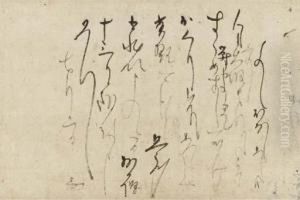Kanamori Sowa Paintings
Kanamori Sowa was a Japanese monk, poet, and calligrapher active during the early Edo period. Born in 1584, Sowa's life was deeply entrenched in the cultural and political transformations occurring in Japan during a time of unification and consolidation under the shogunate. His contributions to the arts, particularly through his calligraphy and poetry, reflect the aesthetic and philosophical shifts of his era, embodying the principles of Zen Buddhism and the emerging ideals of simplicity, naturalness, and a profound appreciation for the subtle and transient beauty of the natural world.
Sowa was not just an artist but also a significant cultural figure, bridging the late Sengoku period and the early Edo period. His works, often characterized by their elegant simplicity and deep contemplation, were highly influenced by the Zen Buddhist philosophy, which he practiced and propagated. Through his art, Sowa sought to express the Zen concepts of impermanence and the beauty of the inherent imperfections found in nature and human existence. His calligraphy, marked by fluid and dynamic strokes, embodies the spontaneity and momentary concentration that Zen Buddhism emphasizes, capturing the essence of the moment in each piece of work.
Beyond his artistic achievements, Kanamori Sowa is remembered for his contributions to the cultural and spiritual life of his time. He played a role in educating and influencing several generations of artists, poets, and thinkers, spreading the aesthetic values of wabi-sabi (the acceptance of transience and imperfection) through his teachings and works. Sowa's legacy is not just in the physical art he left behind but also in his influence on the philosophical and aesthetic orientations of Japanese culture during a pivotal period in its history. He passed away in 1656, leaving behind a body of work that continues to be celebrated for its depth, beauty, and profound philosophical underpinnings.
